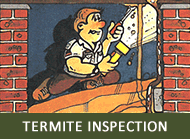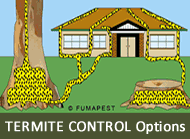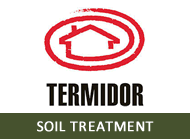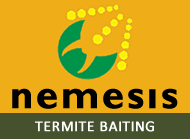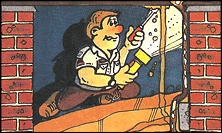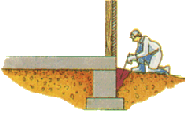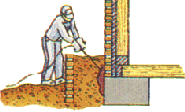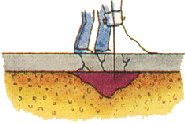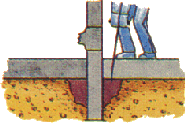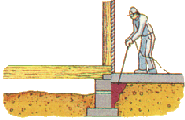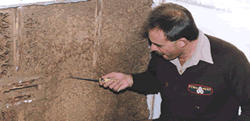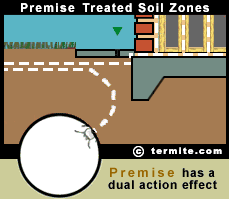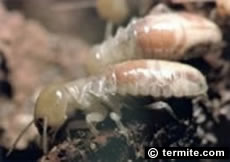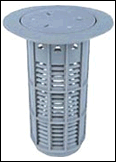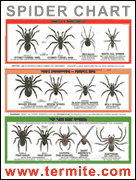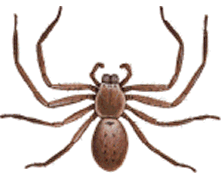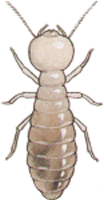| Summary of TERMITE CONTROL Options |
Initial Inspection & Report to A.S.3660 - involve the thorough inspection of all buildings and surrounds - a detailed written report to Australian Standard 3660 - covering areas inspected - evidence found of termite activity - disclosure possible termite entry areas inaccessible to inspection - termite control options and limitations. Chemical Soil Treatment around the perimeter and sub-floor of a building - designed to eradicate termites attempting to gain entry into the building - sometimes a complete barrier not practicable depending on the construction layout of the building - the best long term protection option in vast majority of situations - Termidor or Premise termiticides are recommended. Termite Baiting - installation and monitoring of termite bait stations - Nemesis termite baits. This method relies heavily on the termites "finding" and consuming sufficient bait. Recommended in some limited circumstances, particularly to areas where live termites are found. Building Modification & Maintenance - termite risk reduction measures - may include improving subfloor ventilation - removal of timber in contact with the soil - improving inspection access areas. Subsequent Inspections to A.S.3660 - essential - at least at 3 to 6 months intervals where signs of termite activity has been previously located close by susceptible buildings or timber structures. |
||||||||||||||||
| Termite Inspection Report - Australian Standard 3660 |
| It is essential first and foremost to obtain thorough inspection of the buildings and surrounds, and obtain a written inspection report and detailed specifications to A.S.3660 for an integrated termite control program. It is essential that the inspection and report be received and considered in detail before any protective measures are commenced.
The cost - a professional termite inspection and report to A.S.3660 will cost around $200 to $300 for an average size residential building, depending upon style of construction and ease of inspection access.
Specific areas inspected should include all accessible timbers within the crawl space in the sub-floor, roof void, interior, exterior, garden landscaping, fences, other timber structures and trees in the locality. |
| Your home insurance will NOT cover termite damage to structural and decorative timbers inside a residential or commercial property, which could be severe.
FUMAPEST has Professional indemnity insurance to cover future termite damage to structural and decorative timbers in a building after we have carried out a complete soil treatment service to AS 3660. Termites in the building at the time of chemical soil treatment cannot safely return to their central colony nest through the chemically treated soil. Termites usually return every few days to their central underground to obtain moisture essential for their survival and to feed and groom other termites. Expert knowledge and specialised equipment is required to form a complete and continuous barrier to protect the building from a termite entry and infestation - as illustrated below: |
|
||||||||||||||
| Termite control chemicals are required to be assessed and approved by the Federal Govt agency APVMA
- for example - soil treatment termiticides - Termidor - Premise - Biflex and termite baits - Nemises - Exterra - Sentricon.
Solvent based termiticides are NOT used by FUMAPEST as such products may cause immediate health problems for people with asthmatic or bronchial ailments.
|
Termidor and Premise do NOT have an obnoxious odour or emit airborne residues or fumes. Both are registered as a low hazard insecticide with a CAUTION notation on the registered label.
|
Avoid repellency products: Some alternative termiticides have a strong repellency action to deter foraging termites. Repellant products are less effective in that the termites can detect the chemical and avoid it and move along the treated soil areas, actively seeking a gap to gain entry into the building. Non-repellant products, such as Termidor and Premise are more effective, in that the termites cannot avoid what they cannot detect. The chemical adheres to the skin of the worker termites or they ingest it when tunneling through treated soil areas. These products have a delayed lethal effect - enough time to be taken back to the colony nest and be spread to other termites during their mutual feeding and grooming. With sufficient consumption of the chemical, the entire colony is eliminated.
Premise will act to kill termites, in the higher concentration treated soil areas abutting the building. With Premise, termites that forage in the lower concentrated treated soil areas, will become disorientated, stop feeding, and are fatally diseased by natural fungi and micro-organisms in the soil. |
Both Bayer Premise and BASF Termidor products are scientifically proven to be transferred from one affected termite to another. The technology is aimed at eradicating the queen termite and the entire colony - refer to the animated illustration below:
Worker termites have a very thin waxy skin (called an exoskeleton) that readily absorbs moisture. Both Premise and Termidor adheres to the termite exoskeleton and is readily adsorbed through the exoskeleton and into the termite's body to immobilize and kill the affected termite within a few days. In that time, the termites spread the Premise or Termidor chemical to other termites during regular physical contact, particularly when working together in close proximity, grooming and feeding the rest of the colony, a regular function of their daily life. Cannibals by nature: Termites carry away or cannibalize other dead termites, further spreading the lethal effect of the Premise or Termidor chemical throughout the colony. |
| Termite Baits & Baiting Systems |
Termite baits registered in Australia by the Australian Federal Government APVMA Registration Authority are Nemesis, Exterra and Sentricon brand of termite baits.
How a Nemesis termite bait works: Each termite bait contains an IGR chemical - that is an insect growth regulator - the Nemesis bait contains chlorfluazuron as the active constituent. The worker termites readily eat the bait and pass it onto other termites in the central nest as part of their mutual feeding and grooming process. Termites must regularly molt in their development from nymph to adult. The IGR is slow acting - enough time to spread it's deady effect to other termites in the colony. A cascading lethal effect: The chemical prevents the termites from regrowing their external skeleton, resulting in the death of the termite. Termites cannibalize other dead termites thereby hastening the elimination of the entire colony. Termites have acute survival instincts. The location of a toxic food source if detected, will be abandoned. Too much disturbance of the foraging termites (workers and soldiers) in a particular location, will alert the termite colony to abandon the area. The termites appear to be gone, but may in fact be entering the building in other areas. Your home is a much bigger bait station. Regular monitoring is required: The Nemesis termite baiting system is subject to regular inspection and monitoring by the termite controller. The larger the number of termites that consume the bait, the quicker and more certain is the termite colony elimination process. Baiting is sometimes unreliable: Termite colony elimination in favourable circumstances may take several weeks to a few months. However, in some cases, termite colony elimination is unsuccessful or may take years, depending on the circumstances. It depends if a large number of termites find and consume the bait, then colony elimination is virtually assured within a few months. The experience and skill of the pest controller is paramount, in order to properly decide if and where a baiting program is to be implemented and properly monitored. WARNING: some pest controllers offer termite baiting at ridiculously low prices that does not cover direct materials and labour. BEWARE the pest control licensing system in NSW is inadequate. Some individuals have a NSW Govt WorCover pest control licence with little training or experience. Consumer note: It is usual to reinspect the bait stations and the buildings and surrounds every month to reposition, reapply or replenish the bait, if necessary. This process is labour intensive so that the long term cost of the monitoring and baiting system may accumulate out of hand before the chance of success or otherwise, is realised. |
 |
Ring the Experts: successful termite protection of a building using a baiting program often requires expert skill and judgment, based upon many years of field-work experience in a wide variety of circumstances.
FUMAPEST has been providing professional termite control services in the Strathfield Inner West region for more than 55 years, with a very high success rate for complete termite protection. Live termites found? One critical aspect is the bait stations should to installed in areas where live activity is found. Otherwise the termites must blindly "find" the stations to have any chance of bait consumption and successful elimination. |
CONSUMER NOTICE: Be wary of companies want full payment upfront that promise a timber replacement warranty using a termite baiting and monitoring system. Be careful to read the Contract fine print which stipulates that the so called "warranty" may or may NOT apply at some future point in time when the company decides at it's descretion that the termite colony elimination is successful. |
Your home is a much bigger bait station. Other termite nests may exist in trees, under concrete on-ground flooring and in-fill patios of neighboring properties. These termite nest may be unaffected by the baiting program.. If termites happen to 'find" the in-ground "monitoring" stations, then a bait is placed therein. If this involves sufficient disruption of the termites may avoid the in-ground bait station, entirely. RECOMMENDATION: FUMAPEST apply the Nemesis Termite Bait directly onto known termite activity areas. The rate and amount of consumption is monitored for several weeks. In addition, if practicable thereafter, a complete chemical soil barrier treatment using Termidor or Premise be applied around the immediate perimeter of the building and other high risk entry points. AN INTEGRATED APPROACH: A termite monitoring and baiting program can be integrated with a range of methods including (1) drilling susceptible trees and eradication of any termite nest located therein, and (2) in conjunction with a follow up chemical soil treatment using Termidor or Premise. |
|||
| Listed below are some useful recommendations for the home-owner to carry out in order to help reduce the risk of undetected termite activity inside a building.
Rapid termite colony development and building infestation is usually associated with a readily available timber food and moisture source nearby the central nest. Buildings are often constructed in a way that allow termites to gain undetectable entry from the soil to the structural timbers of the building. (1) Moisture exclusion from inside the wall cavities, around the base of the building and sub-floor area. Exclude excessive water run-off from a sub-floor area by the installation of ag-drains. Make sure there is adequate cross flow ventilation in the sub-floor area. In addition, a qualified plumber should be engaged to ensure there is no water leakage from plumbing pipes in the bathroom, the shower recess, kitchen, down pipes, guttering and air conditioning unit overflow. Look for signs of dampness in the wall cavities, broken roof tiles, faulty guttering and the like. Please note: high humidity, dampness or moisture accumulating in a wall cavity is of high risk to encouraging large scale termite activity inside the building. (2) Removal of any timber in contact with the soil. Timbers should be stored above ground level to allow full inspection for termite activity. Any landscaping using timber chip mulch and railway sleepers should be removed, as they provide ready food source to assist in rapid termite colony development. (3) Ensure inspection access is unimpeded, particularly in sub-floor areas of suspended floors, in order to look for evidence of termite activity. If your home is on concrete slab on-ground flooring, make sure you can inspect the entire external slab edge for evidence of termite mud-shelter tubes. Do NOT allow this area to be covered by pavers, landscaping, planter pots, etc, as termites often gain entry into the wall cavity through external weep holes and gaps in the mortar of brick-work. If you find live termites DO NOT disturb the area. DO NOT use spray insecticides on the termites. If sufficiently disturbed, the termites may move elsewhere and not be rediscovered until severe damage has been done. The termite controller can install a termite bait on the termite activity area aimed at maximising bait consumption by the termites and elimination of the entire colony. |
||
| Regular Follow-up Inspections & Monitoring |
FUMAPEST Policy is usually to recommend 6 or 12 monthly inspections be carried for the first 24 months following a chemical soil treatment. If all seems OK then annually thereafter. FUMAPEST Professional Indemnity Insurance covers subsequent termite damage provided a complete soil treatment and follow-up inspections are carried out to AS.3660. A Word of Warning: the correct identification of a destructive termite species, inspection of a building for tell-tale signs, analysis of your circumstances and the design and implementation of an effective program for the protection of a building from termite infestations, requires expert skill and judgment based upon professional training and extensive field-work experience in termite control in a wide variety of circumstances. |
||||
